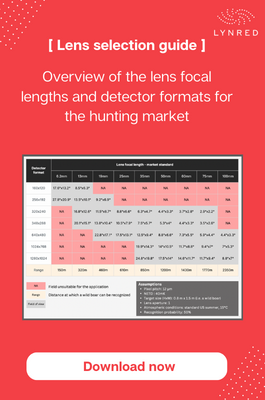please confirm your location
请确认您的位置

QVGA, VGA, XGA or SXGA: which lens format offers the best fit for which leisure application?
September 06, 2023 . 3min read
The latest detectors continue pushing the boundaries of thermal imaging technology with their superior image frequency, resolution, sensitivity and pixel size. These are just some of the criteria that can be used to define a thermal sensor's performance and determine whether it is capable of meeting the needs of the required application.
One of the aspects powering the leisure market's development is the lens format, which therefore means the resolution of the imaging system. The resolution dictates the quality of the resulting image, i.e. a higher sensor resolution equates to a sharper image offering greater accuracy. Higher resolutions can be used to detect and recognize small objects from further away.
The market currently features a number of lens formats that have been designed with specific applications in mind.
So, which formats (QVGA, VGA, XGA or SXGA) offer the best fit for the leisure market in general and particularly the hunting and wildlife observation segments?
- Trend in lens formats for the hunting market
The hunting sector is typically a B2B2C market for prosumers. It is influenced by global trends and passing fashions. The market is home to a community of specialists and enthusiasts who are ready to spend their money on the latest gear if it can help them raise their game. Hunting optics feature a relatively short lifecycle, with manufacturers tending to waste no time in renewing their ranges every 18 to 36 months, and consumers on the lookout for the latest innovations.
The hunting community is dominated by men within the 40 to 55 age bracket, especially in Europe, who can leverage their high purchasing power to buy high-end devices.
When it comes to resolution, hunting optics are caught up in the same trend as visible-light cameras. In other words, efforts are continually focused on reducing the pixel pitch to offer even higher resolutions or aimed at driving down the cost of existing resolutions while delivering robust performance levels.
QVGA is still the most widely distributed format in the hunting market with a resolution of 320 x 240 pixels or 384 x 288 pixels. The market primarily offers solutions boasting a pixel pitch of 12 μm whose performance outstrips products with a pixel pitch of 17 μm, although these products still provide the best sensitivity. Enhancing the NETD (this criterion corresponds to the detector's signal-to-noise ratio and improves when the noise value falls) delivers a more effective response to the use cases in the hunting market by ramping up image quality in low-contrast conditions.
However, the trend is now heading towards VGA formats with a higher resolution (640 x 480 pixels), which is also addressed by products with a pixel pitch of 12 μm, even though products with a pixel pitch of 17 μm continue to occupy a large share of the market due to their sensitivity and the imager's excellent NETD. This trend is actually pulling the VGA format into the mainstream and lowering finished product prices.
VGA-based products are also making greater inroads into the entry-level segment where lens retail prices are less than €2,000. This sub-segment of the hunting market attracts hunters whose financial resources are slightly more limited than hunters in the premium sub-segment.
Finally, the latest trends sweeping the market include the rise of the XGA and SXGA formats with their respective resolutions of 1024 x 768 and 1280 x 1024 pixels in the premium sub-segment.
These new formats offer resolutions that are some 2.5 to 4 times higher, which scales up image quality and supports higher digital zoom levels without any loss of quality compared to the VGA format. The XGA format may seem to be the popular choice with its more affordable price tag, but future consumers will want to keep pace with these improved resolutions by embracing SXGA and higher formats.
- Trend in lens formats for the wildlife observation market
The wildlife observation market paints a contrasting picture to the hunting market, especially in terms of its sizeable community of nature enthusiasts. In addition to possessing a lower level of purchasing power, they are less concerned with the need to continually upgrade their equipment's performance. That explains why most observers use gear with sub-QVGA formats.
The wildlife observation segment is a consumer market that mainly contains products with 160 x 120 and 206 x 156 resolutions and retail prices ranging between €400 and €700. However, falling costs for lens formats delivering greater resolutions, such as QVGA, will fuel the market's development in the short term, which can then harness that growth to procure thermal imaging systems offering higher performance.
Thermal imaging is proving to be a major hit in the hunting market with its night vision capabilities and its ever improving image quality. Manufacturers are constantly developing new lens formats as they strive to push the limits on resolution, which in turn is bringing dynamic growth to the market and helping carve out new segments.
If you would like to find out more about the leisure market in general and specifically the technical characteristics of the imaging systems for each market segment, then download the free selection guide below.



